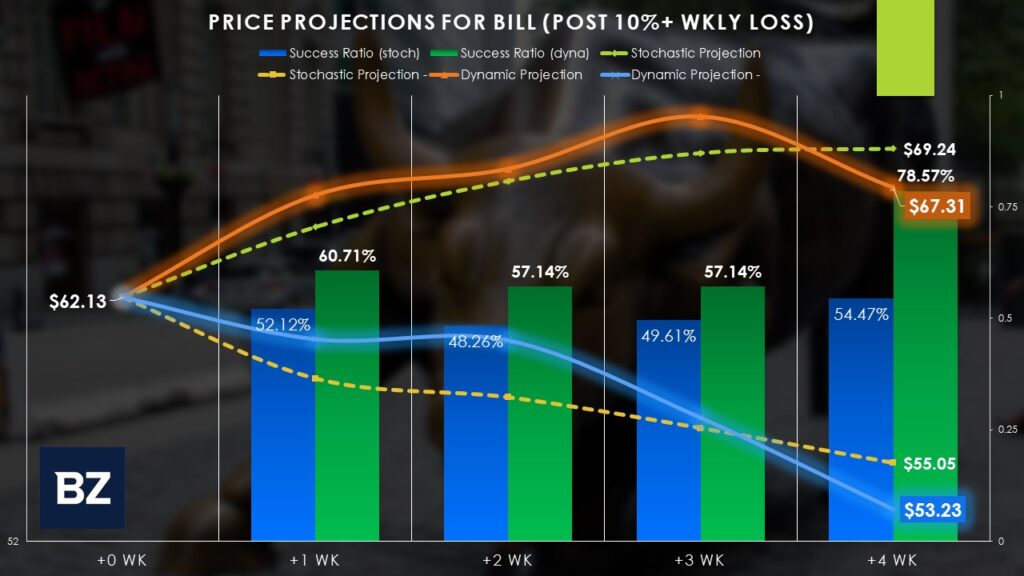Zinger Key Points
- Payment processing specialist Bill Holdings tanked spectacularly last week due to slowing revenue fears.
- Most of the Street appears to be overlooking the wild value proposition and statistical bounce-back tendencies.
- Find out which stock just plummeted to the bottom of the new Benzinga Rankings. Updated daily—spot the biggest red flags before it’s too late.
On the surface, payment processing specialist BILL Holdings Inc BILL has no business imploding the way it did last week. On Thursday, the company posted fiscal second-quarter financial results, generating revenue of $362.55 million and adjusted earnings per share of 56 cents. These stats beat analysts' consensus estimates of $360.23 million and 46 cents, respectively. Nevertheless, BILL stock tanked following the results.
Even breaking down certain elements, it wasn't readily apparent for those unfamiliar with the broader context why the payment processor stumbled. For example, total revenue increased 14% year-over-year while core revenue — which consists of subscription and transaction fees — climbed 16%. Further, BILL ended the quarter with $1.57 billion in cash and cash equivalents.
Providing an intriguing framing of the results, management articulated that it is seeking "to empower small and mid-sized businesses," a segment that falls under BILL's bread and butter. The kicker was that the company raised its full-year outlook to revenue of $1.45 billion to $1.47 billion. This guidance compares favorably to the prior estimate of $1.46 billion.
Despite these seemingly stellar numbers, BILL stock imploded on Friday, begging the obvious question — why? KeyBanc analysts Alex Markgraff may have summed up the situation the best, stating that his prior expectations of growth were off and that BILL deserved its equity erosion. Other analysts alluded to Q3 guidance being flat rather than anything game-changing.
Generally speaking, the Q2 results were good, but concerns started to creep in about slowing sales growth. In addition, BILL's exposure to small and mid-sized businesses (SMBs) may have spooked investors, amid some fears of significant economic challenges.
Also Read: JD Vance ‘Quarterbacking’ TikTok Deal: Will His Venture Capital Experience Secure A Win?
BILL Stock Now Presents a Tempting Value Proposition
Given the broader context, the question isn't so much about whether BILL stock deserved to have a reduction in the share price; rather, it's about the magnitude of the decline. Prior to the selloff, BILL traded hands near the $100 level. At time of writing, it's exchanging hands at around $65. This implosion has value hunters salivating.
Presently, BILL stock carries a trailing earnings multiple of over 159 times. However, on a forward basis, BILL trades at just under 37 times earnings. As well, assuming revenue lands at the guidance midpoint of $1.46 billion, the equity is priced at only 4.63 times projected sales. During the first calendar quarter last year, the sales multiple averaged 6.13 times.
Yes, economic concerns linger, and BILL's exposure to SMBs presents a risk factor. However, it's also fair to point out that while the January jobs report came in technically below expectations, overall jobs growth in December was unusually strong. Amid the noise within the data, some analysts argue that the labor market stands on solid ground.
Still, the most compelling argument could be the statistical data undergirding BILL stock. Using data from the past five years, BILL demonstrates an upward bias. A position entered at the beginning of the week has a 52.12% chance of rising by the end of it. Over a four-week period, the long odds improve to 54.47%.

Even more enticing, rather than viewing the data from a simple stochastic or temporal framework, one can filter the data through a dynamic lens. Last week, BILL stock dropped 33.83% — an extreme-fear event if there ever was one. Whenever BILL has lost 10% or more in a one-week period (in the past five years), there's a 60.71% chance that it will rise one week later. Over four weeks, the long odds soar to 78.57%.
Strategizing a Bullish Options Trade
One critical caveat to the high long odds is that the median return under the positive scenario isn't particularly remarkable. Four weeks following an extreme-fear event (losing 10% or more in one week), the median return is 8.34%. That comes out to $67.31 based on Friday's closing price, which is lower than the $69.24 target, which would be calculated using a stochastic framework.
Without getting too deep into the weeds, it's likely that market makers are anticipating a rebound in BILL stock. Therefore, the call options are probably priced at a richer-than-normal premium. Because of this situation, it may be better to consider a narrower bull call spread. While this approach greatly exacerbates the risk that the entire spread will expire completely worthless, the net debit required for a wider and thereby more "protective" spread may be onerous.
With that in mind, one idea to consider is the 64/67 bull call spread (buy the $64 call, simultaneously sell the $67 call) for the options chain expiring March 7. Since BILL stock realistically has a chance of poking its head above $67 by expiration, the short call strike price gives the trader a strong chance of attaining the maximum payout (which at time of writing stands at around 87%).
Also, the $64 long call provides the potential opportunity of salvageable value if the bullish thesis doesn't quite pan out. Out of the available call spreads, the 64/67 spread may be among the most sensible given the circumstances.
Read Next:
Photo: Ground Picture/Shutterstock.com
Edge Rankings
Price Trend
© 2025 Benzinga.com. Benzinga does not provide investment advice. All rights reserved.
Trade confidently with insights and alerts from analyst ratings, free reports and breaking news that affects the stocks you care about.